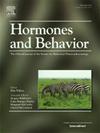Hormonal lockdown: How mole-rat societies enforce infertility in helpers
IF 2.4
3区 医学
Q2 BEHAVIORAL SCIENCES
引用次数: 0
Abstract
Reproductive suppression is a defining feature of cooperative breeding, yet the hormonal mechanisms regulating infertility in non-breeding individuals remain poorly understood. This study examines associations between circulating prolactin (PRL) and faecal metabolites of androgens (fAM), glucocorticoids (fGCM), and progesterone (fPM) in relation to socially induced infertility in two closely related cooperatively breeding mole-rat subspecies: the highveld (Cryptomys hottentotus pretoriae) and Natal mole-rat (C. hottentotus natalensis). Our results reveal a fundamental dichotomy in reproductive suppression strategies. Highveld mole-rats exhibited seasonally elevated circulating PRL in non-breeders during the dry season, coinciding with reduced pituitary responsiveness to exogenous gonadotropin-releasing hormone (GnRH) and lower gonadal steroid metabolites. These associations are consistent with PRL involvement in physiological suppression of the hypothalamic-pituitary-gonadal (HPG) axis, but causality cannot currently be inferred. In stark contrast, Natal mole-rats showed relatively low and stable PRL levels across reproductive groups and seasons, with breeders exhibiting higher androgen and progesterone metabolites compared to non-breeders, a pattern consistent with behavioural suppression through incest avoidance, aggression or social dominance. These findings highlight the adaptive flexibility of cooperatively breeding systems and provide new insights into the hormonal architecture of reproductive suppression. Although the present findings do not establish causality, they delineate key hormonal and behavioural pathways that warrant future investigation.
荷尔蒙锁定:鼹鼠社会如何强制帮助者不孕。
生殖抑制是合作繁殖的一个决定性特征,然而调节非繁殖个体不育的激素机制仍然知之甚少。本研究在两个密切相关的合作繁殖的鼹鼠亚种:高原(Cryptomys hottentotus pretoriae)和出生鼹鼠(C. hottentotus natalensis)中,研究了循环催乳素(PRL)和雄激素(fAM)、糖皮质激素(fGCM)和孕酮(fPM)的粪便代谢产物与社会诱导不孕之间的关系。我们的研究结果揭示了生殖抑制策略的基本二分法。旱季时,高原鼹鼠的循环PRL呈季节性升高,这与垂体对外源性促性腺激素释放激素(GnRH)的反应性降低和性腺类固醇代谢物降低相一致。这些关联与PRL参与下丘脑-垂体-性腺(HPG)轴的生理抑制是一致的,但目前还不能推断出因果关系。与此形成鲜明对比的是,在繁殖组和繁殖季节,纳塔尔鼹鼠的PRL水平相对较低且稳定,繁殖组的雄性激素和孕激素代谢产物高于非繁殖组,这种模式与通过避免乱伦、攻击或社会支配来抑制行为相一致。这些发现突出了合作繁殖系统的适应性灵活性,并为生殖抑制的激素结构提供了新的见解。虽然目前的发现没有建立因果关系,但它们描绘了关键的激素和行为途径,值得未来的研究。
本文章由计算机程序翻译,如有差异,请以英文原文为准。
求助全文
约1分钟内获得全文
求助全文
来源期刊

Hormones and Behavior
医学-行为科学
CiteScore
6.70
自引率
8.60%
发文量
139
审稿时长
91 days
期刊介绍:
Hormones and Behavior publishes original research articles, reviews and special issues concerning hormone-brain-behavior relationships, broadly defined. The journal''s scope ranges from laboratory and field studies concerning neuroendocrine as well as endocrine mechanisms controlling the development or adult expression of behavior to studies concerning the environmental control and evolutionary significance of hormone-behavior relationships. The journal welcomes studies conducted on species ranging from invertebrates to mammals, including humans.
 求助内容:
求助内容: 应助结果提醒方式:
应助结果提醒方式:


